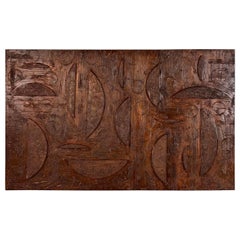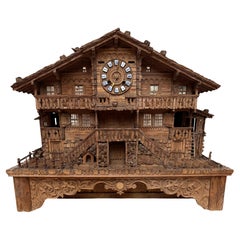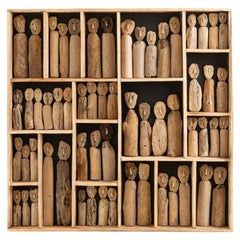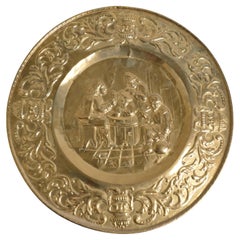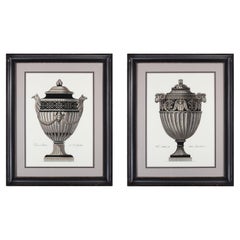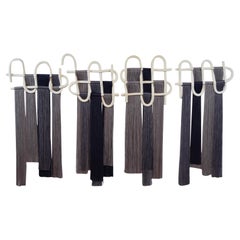Hand-Crafted Decorative Art
1970s Italian Mid-Century Modern Vintage Hand-Crafted Decorative Art
Plaster, Wood, Paint
Late 19th Century Swiss Black Forest Antique Hand-Crafted Decorative Art
Enamel, Brass, Iron
21st Century and Contemporary European Bohemian Hand-Crafted Decorative Art
Wood, Driftwood
Early 20th Century English Tudor Hand-Crafted Decorative Art
Brass
21st Century and Contemporary Italian Neoclassical Hand-Crafted Decorative Art
Wood, Paper
2010s American Organic Modern Hand-Crafted Decorative Art
Ceramic, Cotton
Late 20th Century French Hand-Crafted Decorative Art
Plaster
2010s Colombian Hand-Crafted Decorative Art
Cast Stone
21st Century and Contemporary Italian Neoclassical Hand-Crafted Decorative Art
Gold Leaf
2010s American Organic Modern Hand-Crafted Decorative Art
Ceramic, Stoneware, Linen
Early 19th Century American Regency Antique Hand-Crafted Decorative Art
Giltwood, Paper
Early 20th Century French Hand-Crafted Decorative Art
Plaster
2010s American Organic Modern Hand-Crafted Decorative Art
Ceramic, Stoneware, Linen
Late 20th Century Unknown Arts and Crafts Hand-Crafted Decorative Art
Wood
2010s American Organic Modern Hand-Crafted Decorative Art
Ceramic, Stoneware
21st Century and Contemporary French Country Hand-Crafted Decorative Art
Gold Leaf
Late 20th Century French Hand-Crafted Decorative Art
Plaster
1970s American Other Vintage Hand-Crafted Decorative Art
Lucite
Early 20th Century Dutch Arts and Crafts Hand-Crafted Decorative Art
Brass
Early 20th Century German Arts and Crafts Hand-Crafted Decorative Art
Metal, Iron
Early 20th Century European Art Deco Hand-Crafted Decorative Art
Wool
Early 20th Century Dutch Art Deco Hand-Crafted Decorative Art
Wood
Late 19th Century French Antique Hand-Crafted Decorative Art
Canvas, Giltwood
Late 19th Century European Victorian Antique Hand-Crafted Decorative Art
Brass
21st Century and Contemporary Italian Neoclassical Hand-Crafted Decorative Art
Wood, Paper
1950s French Mid-Century Modern Vintage Hand-Crafted Decorative Art
Stoneware
Early 20th Century European Arts and Crafts Hand-Crafted Decorative Art
Metal, Brass
1930s French Art Deco Vintage Hand-Crafted Decorative Art
Metal, Brass
Early 20th Century European Art Deco Hand-Crafted Decorative Art
Plaster, Wood
Mid-20th Century Italian Art Deco Hand-Crafted Decorative Art
Alabaster, Metal
21st Century and Contemporary Italian Neoclassical Hand-Crafted Decorative Art
Wood, Paper
1970s German Modern Vintage Hand-Crafted Decorative Art
Wood, Velvet
21st Century and Contemporary Italian Neoclassical Hand-Crafted Decorative Art
Wood, Paper
Late 19th Century French Napoleon III Antique Hand-Crafted Decorative Art
Metal
21st Century and Contemporary Italian Neoclassical Hand-Crafted Decorative Art
Wood, Paper
Late 20th Century French Hand-Crafted Decorative Art
Plaster
Early 20th Century French Art Deco Hand-Crafted Decorative Art
Metal, Brass
Mid-20th Century Danish Mid-Century Modern Hand-Crafted Decorative Art
Ceramic, Pottery, Wood, Oak
2010s Austrian Jugendstil Hand-Crafted Decorative Art
Brass
Mid-20th Century Italian Mid-Century Modern Hand-Crafted Decorative Art
Enamel
Mid-20th Century French Mid-Century Modern Hand-Crafted Decorative Art
Wicker, Cane, Rattan, Mirror
Mid-20th Century Italian Mid-Century Modern Hand-Crafted Decorative Art
Metal, Brass
21st Century and Contemporary Japanese Hand-Crafted Decorative Art
Silk, Brocade
19th Century British Early Victorian Antique Hand-Crafted Decorative Art
Paper
1920s German Folk Art Vintage Hand-Crafted Decorative Art
Wood, Paper
21st Century and Contemporary Italian Neoclassical Hand-Crafted Decorative Art
Gold Leaf
20th Century American Mid-Century Modern Hand-Crafted Decorative Art
Metal
Early 1900s English Victorian Antique Hand-Crafted Decorative Art
Glass
Mid-20th Century Guatemalan Spanish Colonial Hand-Crafted Decorative Art
Wool
Late 19th Century Swedish Antique Hand-Crafted Decorative Art
Acrylic, Wood, Paper, Faux Bamboo
Early 20th Century German Art Nouveau Hand-Crafted Decorative Art
Bronze
Mid-20th Century Mexican Mid-Century Modern Hand-Crafted Decorative Art
Amethyst, Carnelian, Lapis Lazuli, Malachite, Multi-gemstone, Opal, Tour...
21st Century and Contemporary European Mid-Century Modern Hand-Crafted Decorative Art
Wool
20th Century Moroccan Hand-Crafted Decorative Art
Leather
Mid-19th Century Indian Anglo-Indian Antique Hand-Crafted Decorative Art
Silk, Blown Glass, Ebony
Late 19th Century Japanese Meiji Antique Hand-Crafted Decorative Art
Bamboo
1890s Syrian Islamic Antique Hand-Crafted Decorative Art
Metal, Brass
Early 20th Century Moroccan Moorish Hand-Crafted Decorative Art
Ceramic
21st Century and Contemporary Italian Hand-Crafted Decorative Art
Crystal, Stainless Steel
2010s Italian Hand-Crafted Decorative Art
Paper, Paint
Read More
At Colonial Williamsburg, Everything Old Is New Again
With the help of a new director, the Virginia institution's folk art and decorative arts museums are undergoing extensive upgrades.
New York’s Hirschl & Adler Showcases the American Workmanship and Design Panache of Neoclassical Treasures
The gallery's latest exhibition proves that museum-quality pieces entice and inspire, whether in traditional or more modern interiors.
